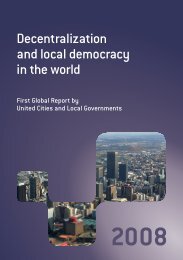Making Cities Resilient Report 2012
Making Cities Resilient Report 2012
Making Cities Resilient Report 2012
Create successful ePaper yourself
Turn your PDF publications into a flip-book with our unique Google optimized e-Paper software.
What do we mean by a resilient city<br />
Although no city can ever be entirely safe from natural hazards, they can be more resilient to the<br />
destructive forces that claim lives and assets. A resilient city is characterized by its capacity to withstand<br />
or absorb the impact of a hazard through resistance or adaptation, which enable it to maintain certain<br />
basic functions and structures during a crisis, and bounce back or recover from an event (Twigg, 2007;<br />
UNISDR, terminology).<br />
At the outset, the Campaign defined a resilient city as one where:<br />
• Disasters are minimized because the population lives in homes and communities with organized<br />
services and infrastructure that adhere to sensible building codes; without informal settlements<br />
built on flood plains or steep slopes because no other land is available.<br />
• An inclusive, competent and accountable local government is concerned about sustainable<br />
urbanization and that commits the necessary resources to develop capacities to manage and<br />
organize itself before, during and after a natural hazard event.<br />
• The local authorities and the population understand their risks and develop a shared, local<br />
information base on disaster losses, hazards and risks, including who is exposed and who is<br />
vulnerable.<br />
• People are empowered to participate, decide and plan their city together with local authorities and<br />
value local and indigenous knowledge, capacities and resources.<br />
• Steps are taken to anticipate and mitigate the impact of disasters, incorporating monitoring and<br />
early warning technologies to protect infrastructure, community assets and individuals, including<br />
their homes and possessions, cultural heritage, environmental and economic capital, and is able<br />
to minimize physical and social losses arising from extreme weather events, earthquakes or other<br />
natural or human- induced hazards.<br />
• There is an ability to respond, implement immediate recovery strategies and quickly restore basic<br />
services to resume social, institutional and economic activity after such an event.<br />
• An understanding exists that most of the above is also central to building resilience to adverse<br />
environmental changes, including climate change, in addition to reducing greenhouse gas<br />
emissions.<br />
What makes a city resilient to natural and human-induced hazards can be seen as a combination of<br />
resilience accumulated through the process of urbanisation and planning, on one-hand, and the result of<br />
specific actions to reduce disaster risk on the other.<br />
Sound development practice with good regulations, well-maintained infrastructure, capable emergency<br />
management and solid institutions, which develop participatory urban plans, provide building permits, and<br />
manage water resources and solid waste, help to build up cities’ resilience over time. Political processes<br />
and decision making that have addressed particular needs, or reduced risks, as the city was constructed<br />
will provide safe, good quality living conditions for everyone and protect the most vulnerable. This type of<br />
‘accumulated resilience’ makes the city function on a daily basis .<br />
A city also builds resilience through the engagement of its government, citizens and other stakeholders in<br />
the process of disaster risk reduction, where specific actions are taken to identify, manage and lessen the<br />
impacts of natural and human-induced hazards.<br />
The following chapters review how local governments at various stages of economic and social development,<br />
with varying sizes and facing different hazards and risks, are adopting the traits characteristic of resilient<br />
cities, and taking steps to address current gaps and challenges.<br />
<strong>Making</strong> <strong>Cities</strong> <strong>Resilient</strong> <strong>Report</strong> <strong>2012</strong> | 11

















